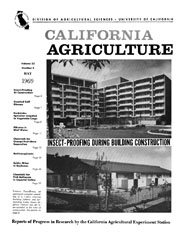


University of California
California Agriculture



|
|||
|
|||

Insect-proofing during building construction.
Cover:
Ventura TownHouse, an apartment complex consisting of a 7-story concrete building (above) and surrounding frame house duplexes (below) was all insect- proofed at the time of construction.
May 1969
Volume 23, Number 5 |
|||
|
University of California, 1301 S. 46th St., Bldg. 478 Richmond, CA
|